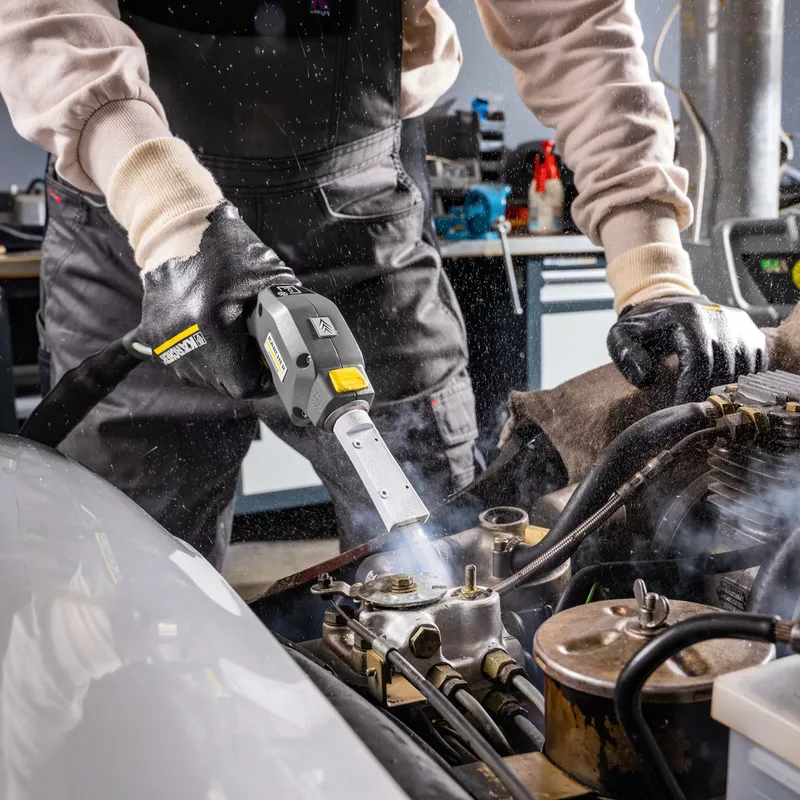
Blasting the chassis with dry ice. Which dry ice machines are used in the industry? Benefits of cleaning
Content
- Dry ice blasting - what does it mean?
- Benefits of cleaning surfaces with dry ice
- Dry ice and residue blasting - what about carbon dioxide?
- Dry ice surface cleaning technology - where to use it? Only in the industrial sector?
- Dry ice blasting and its disadvantages
- Dry ice and operator conditions
- How much does dry ice blasting cost?
- Repairing cars with dry ice - does it make sense?
Removal of dirt from the surface is usually done with water, detergents or abrasives and compressed air. Dry ice cleaning is only possible with dry ice pellets made from CO2. However, this is not as common as sandblasting. These methods are somewhat similar, and some people confuse them. Correctly? See if washing with dry ice will get rid of dirt from the surface of the car. Read!
Dry ice blasting - what does it mean?
In terms of the materials used and the effects of the job, sandblasting is not the best term for dry ice cleaning. Dry ice pellets are used in this process. They are formed as a result of the expansion of liquid carbon dioxide and its compression. The result of this technological process are two types of granules, 3 and 16 mm, which are used for different purposes. Sandblasting and iceblasting are related only to the way the granulate/abrasive is fed. This requires a machine in combination with a compressor that applies the granulate/abrasive at a pressure of several bar.
Benefits of cleaning surfaces with dry ice
This method of getting rid of dirt has a number of advantages. First, dry ice cleaning does not require the use of detergents. Thus, it can be implemented in machine lines in the food industry. In this way, you can deal with defects present on delicate surfaces that cannot be sandblasted. Another factor in favor of using this method is the purity of the process itself. Why can you say that?

Dry ice and residue blasting - what about carbon dioxide?
The only by-product here is the frozen dirt that falls next to the work area. What is dry ice blasting method? The granules are accelerated to a speed of more than 150 m/s and fall between the surface to be cleaned and the dirt. The temperature of pollutants drops sharply. They are separated from the material and removed by the air flow. What is extremely important, industrial dry ice does not melt, but sublimates. Thus, the liquefaction phase is eliminated as the granulate evaporates. Statement? The side effect is only CO2 and dirt.
Dry ice surface cleaning technology - where to use it? Only in the industrial sector?
Companies offering industrial cleaning with dry ice indicate that this is a spot method. What does it mean? Cleaning large formats may not be possible due to the small diameter of the granulate injection nozzles. On large surfaces, a decrease in the effectiveness of this method can be observed. Therefore, not all objects and machines can be updated and restored using this technique. However, it is widely used in industry:
- automobile;
- pharmaceutical;
- grocery;
- cosmetics;
- metallurgical;
- wood;
- seal;
- electric.

Dry ice blasting and its disadvantages
The fact that this method is mainly for spot cleaning can be both a disadvantage and an advantage. It is effective in restoring small items or hard-to-reach. However, dry ice blasting has its drawbacks. It:
- the need to quickly use the produced granules. They are prone to sublimation and are no longer suitable for machine cleaning after 16 hours;
- the high cost of the equipment used for such work (up to 100 euros), so the only option is to take advantage of the offer of companies specializing in dry ice cleaning services.
Dry ice and operator conditions
The person performing the maintenance must observe special safety precautions when working in enclosed spaces. Mere contact with dry ice granules can be dangerous as they are very cold and can damage the skin upon contact. Another thing is the noise level, which usually ranges from 70-100 dB. Dry ice blasting in confined spaces requires shielding to protect other components from damage, as well as the use of high quality hearing protection and oxygen masks. The escaping carbon dioxide displaces the oxygen and it may be difficult for the operator to breathe.
How much does dry ice blasting cost?
Several factors affect the final cost of dry ice cleaning. It's all about time, the amount of dry ice used, the energy needed to run the equipment, and the cost of the operator. Therefore, it usually fluctuates between 300-40 euros per hour. Compared to sandblasting, this is quite a lot, but it should be noted that this method is used in a different sector of work.

Repairing cars with dry ice - does it make sense?
Restoring a car with this method can be really effective. The price of such a service is quite high, but the effect will be at least impressive. Just look at the photos posted on the net of car chassis parts restored using dry ice cleaning. In principle, suspension parts, chassis and even the engine can be updated in this way. What is extremely important, there is no fear of damaging other parts with an abrasive. There will also be no detergent residue or the need to dry.
On the Internet you will find more and more offers from companies specializing in dry ice blasting. Should they be used? Small items can be upgraded for less, but if you have a vintage car and want it to look impressive, you can opt for this modern method.